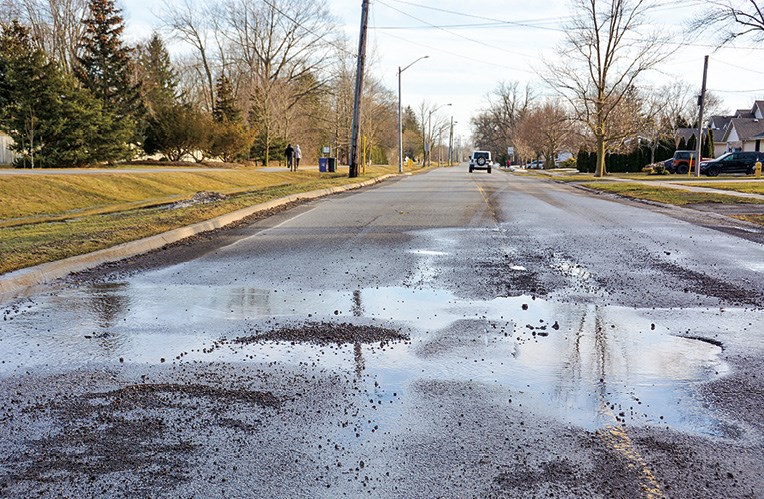Peak season sees 300 fills per week
From 2003 to 2021, 12 stretches of asphalt from across Ontario have topped the Canadian Automobile Association (CAA) Worst Roads list. The good news is that no Pelham street or highway has ever made the list.
Pelham’s Director of Public Works, Jason Marr, told the Voice that the Town maintains all local roads, with the exception of Highway 20, RR 24 (Victoria Avenue), RR 29 (Webber Road), and RR 54 (Rice Road), which are the responsibility of the Region.
“This time of year, filling potholes is a full-time job for our roads crews, which consist of five operators and a supervisor,” said Marr. “The local asphalt plants in the area are closed for the winter, and do not usually reopen until sometime in April. As a result, the filling of potholes is completed using cold patch materials. To date this calendar year, we have ordered just over 60 tons of cold patch materials. This is tracking to be more material than what was ordered last year, an indication that our roads are being negatively impacted by the winter season.”
The cold-patch repairs don’t tend to be permanent fixes, a direct result of repeated freeze/thaw cycles, plowing operations, and the application of de-icing materials. March and April are primetime for patching potholes, identified through Public Service Requests (PSRs) and through routine Public Works road patrols.
“This is also the time of year when we discover how bad the winter season has affected our road network, and is the start of the process of developing the annual asphalt rehabilitation and base repair program,” aid Marr. “Roads of particular current concern include Effingham Street from Hwy 20 to Tice Road, Welland Road from Effingham Street to Dorothy, and many of the rural roads in North Pelham.”
Bob Goodfield, Pelham’s Supervisor of Roads, said that, “Last year I filled a banker’s box of work orders. I requested the third load of cold patch at the end of February. The first load was February 11, the second was February 24. It seems worse than last year, as we are swamped with holes right now.”
Pelham’s Manager of Public Works, Ryan Cook, begs to differ, suggesting that the pothole volume is pretty much in keeping with past winters.
“I’d say it's about the same as last year. I mean, it depends who you talk to you,” said Cook. “I think every year we forget how bad it was the year previous, so I don't think there's any real difference.”
Once identified, there is only a certain amount of time before a pothole has to be filled, said Cook.
“It depends on the classification of the roadway. A Class Three road, like Pelham Street, would be about two weeks, while a Class Five rural road would be longer.”
Winter cold patches are a product called QPR (“quality pothole repair”) which can be applied in the wet and cold, with no mixing required. Once compacted, traffic can flow over it immediately. When the weather warms up, a hot patch is the preferred infill. It performs like regular asphalt, and lasts longer.
“Off the top my head, we're probably pushing 300 pothole fills a week at this time of year,” said Cook. “I don't think that's unusual at all. On an annual basis, we do about 110 tons of cold patch, December through March. And then for the rest of the year, we roll out about 85 tons of hot patch.”



